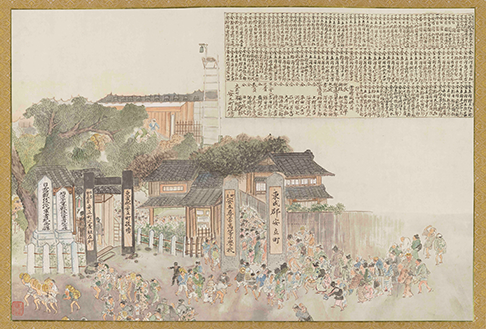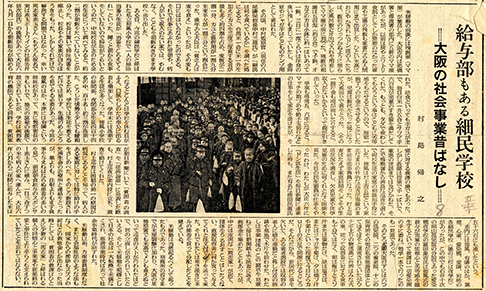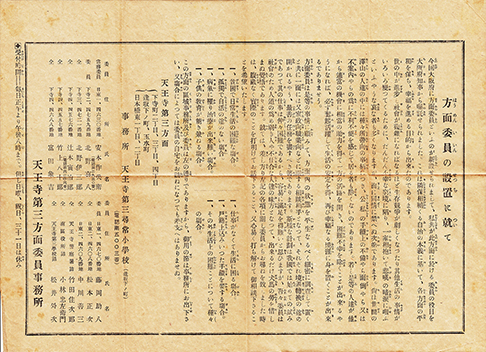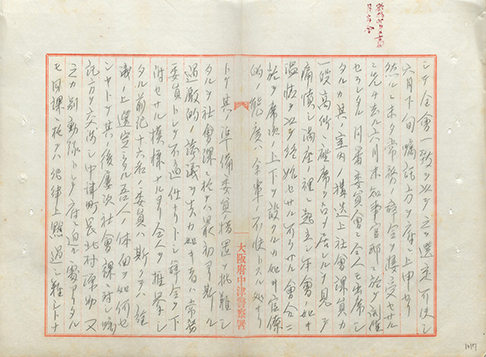
Rice Riots in Osaka; 1918;
held in the Office of the Editors for Osaka City History

This painting depicts a rice market where rice was sold at a lower price, which opened at Municipal Anryu Higher Elementary School in Anryu-machi (present-day Suminoe ward) during the Rice Riots. Names of individuals who donated money and goods to the market and the amount of money donated are shown in the upper-right. The Osaka prefectural and municipal governments opened similar markets in each elementary-school district in Osaka City, and many of the influential persons who cooperated in holding the market within the school districts were later appointed welfare commissioners. Donations were received from wealthy persons to fund the markets held in Osaka City and the balance of the funds was used for the operation of the welfare commissioner system.
“An elementary school for the poor that has a public relief department,”
an article written by Murashima Yoriyuki
Source: Osaka no shakaijigyo (Social welfare service in Osaka),
117th issue dated April 30, 1960; owned by Ms. Murashima Chieko

This article says, “Before the Rice Riots, police officers played the role of what we call social workers today in Osaka.” According to the article, a police officer was assigned to the public relief department of Tokufu Elementary School, a school for the poor established by the police in the Imamiya district. The police officer visited households of children to investigate their living conditions, and took care of children who hadn’t eaten enough or had difficulty in attending school. This article shows that the police worked to stabilize the social order already before the occurrence of the Rice Riots. Ironically, however, the Imamiya district was among the first areas in Osaka where Rice Riots broke out. This exhibition will also shed light on the measures newly introduced by the police in the Imamiya district after the Rice Riots. Murashima Yoriyuki (1891–1965) who wrote this article was a reporter for the Osaka Mainichi Shimbun who was active in the prewar days. He published reports and reportages on poor people, and was known as a “guide to lower-class society.”
Announcement of the establishment of the welfare commissioner system; 1918; held in the Archives of St. Andrew’s University

Upon the establishment of the welfare commissioner system, printed announcements such as this were produced, posted and distributed to residents in the areas where welfare commissioners were appointed. These announcements were written to be easy to understand (e.g. by paraphrasing difficult words written in kanji characters, using kana characters.) The third Tennoji area for which this announcement was produced included the Shitadera-machi district (present-day Naniwa ward) where the first riot broke out in Osaka on August 11. Names of the welfare commissioners are listed in the latter part of the announcement. Among the commissioners, we can see the name, Tomita Shokichi (1878–1943), who was a director of Ishii Memorial Aizen-en (present-day Social Welfare Corporation Ishii Memorial Aizen-en) which ran a kindergarten and elementary school for the poor in this area.
Report on an incident caused by a welfare commissioner of the Nakatsu-machi district (addressed to the director of the Osaka Prefectural Police Department from the chief of the Nakatsu police station) dated September 16, 1922;
held in the Osaka Prefecture Archive

In 2007, files of public documents titled “Incidents caused by welfare commissioners” were discovered in the building of the Osaka prefectural government. These documents contained detailed descriptions of unknown realities of welfare commissioners in the early days of the establishment of the welfare commissioner system. This report is one of these documents, and it describes an incident caused by Saeki Yusho (1896–1945), the older brother of renowned painter, Saeki Yuzo (1898–1928). Saeki Yusho attended a committee meeting as a newly appointed welfare commissioner of the Nakatsu-machi district (present-day Kita ward), when he criticized the seating arrangement that placed the seats of officials of the Osaka prefectural government at a higher level as being “bureaucratic.” He had been nominated to be a senior commissioner (representative commissioner) of the Nakatsu-machi district, but because of this incident, he was not appointed to the post. These public documents contain detailed descriptions of behaviors and ideologies of individual commissioners, such as the incident of Saeki Yusho. This exhibition will showcase all 15 files of the documents titled “Incidents caused by welfare commissioners,” and materials related to Saeki Yusho, along with a painting by Saeki Yuzo, Notre-Dame at Night (Mantes-la-Jolie) (1925) which was long owned by Osaka Prefectural Kitano Senior High School, Yuzo’s alma mater, and is now held by the Planning Office, Osaka City Museum of Modern Art.
